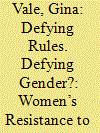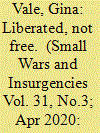|
|
|
Sort Order |
|
|
|
Items / Page
|
|
|
|
|
|
|
| Srl | Item |
| 1 |
ID:
191483


|
|
|
|
|
| Summary/Abstract |
Through disproportionate restrictions placed on women’s movement and visualization within its “caliphate”, the Islamic State (IS) group enforced its policies of female domesticity and submission. Studies on IS governance of local Iraqi, Syrian and Kurdish women have focused overwhelmingly on their victimization, abuse, and restricted agency. By contrast, this paper uncovers the opportunities, activities, and impacts of individual and collective nonviolent resistance led by local Sunni and Yazidi women. Through endeavors such as personal resilience, individual confrontations, and even group protest, local female civilian women acted against the group’s policies, members, ideology, and expectations of female passivity.
|
|
|
|
|
|
|
|
|
|
|
|
|
|
|
|
| 2 |
ID:
173843


|
|
|
|
|
| Summary/Abstract |
In 2014, the Islamic State (IS) group launched a genocidal campaign against the Yazidis in Northern Iraq. IS used varied means to attack and fragment the Yazidi community: massacre of men; indoctrination and training of young boys; forced conversion of families; and kidnapping, enslavement, and rape of women and girls. Academic and policy attention has predominantly focused on IS’ sexual violence and rape of young Yazidi women and girls. This has led to the accounts of other female captives – namely, older women and undivided families – being overlooked or undervalued, excluding important elements of IS’s broader strategy of persecution. This paper analyses women’s varied experiences of captivity to reveal a fragmented population of female captives and seeks to demonstrates that IS exploited Yazidism’s religious and sociocultural customs to ensure that the impacts of its genocide – for the women themselves and the wider Yazidi community – continue beyond liberation. It concludes that although progress has been made to cope with trauma, displacement, and abuse, the community remains both physically and culturally fragmented.
|
|
|
|
|
|
|
|
|
|
|
|
|
|
|
|
|
|
|
|
|